

Incredible Shrinking Notes. Subjects Language Arts (Study Skills) Note: This activity can be used with a selection from literature or nonfiction reading materials related to science, history, and many other subjects.
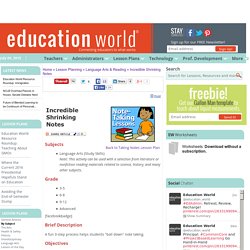
Grade 3-56-89-12Advanced [facebookbadge] Brief Description A fun 3-step process helps students "boil down" note taking. Objectives Students will Listen to or read a brief biography of Amelia Earhart or another grade-appropriate reading selection. Keywords note taking, notes, listening, Earhart, study skills, research Materials Needed[shopmaterials] three "sticky notes" or index cards in three different sizes -- approximately 3- x 5 inches, 3 x 3 inches, and 1 x 2 inches - for each student a brief biography of Amelia Earhart or another grade-appropriate reading selection Lesson Plan About the Lesson This lesson uses a brief biography of Amelia Earhart as the starting point for note-taking exercises. To begin, give each student a sticky note or index card roughly 3- x 5-inches in size. Assessment Education World. Scientists and Inventors. Biographies of Scientists and Inventors Alexander Graham Bell - Invented the telephone.
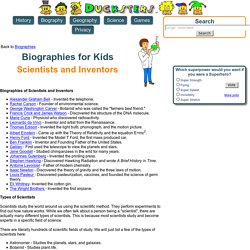
Rachel Carson - Founder of environmental science. George Washington Carver - Botanist who was called the "farmers best friend. " Francis Crick and James Watson - Discovered the structure of the DNA molecule. Marie Curie - Physicist who discovered radioactivity. Leonardo da Vinci - Inventor and artist from the Renaissance. Scientists study the world around us using the scientific method. Skimming Activities for Kids. Skimming is the skill used to locate the main idea of a text in a quick and efficient manner.
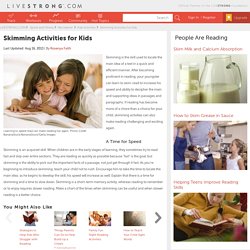
After becoming proficient in reading, your youngster can learn to skim-read to increase his speed and ability to decipher the main and supporting ideas in passages and paragraphs. If reading has become more of a chore than a choice for your child, skimming activities can also make reading challenging and exciting again. Skimming is an acquired skill. When children are in the early stages of learning, they sometimes try to read fast and skip over entire sections. They are reading as quickly as possible because "fast" is the goal, but skimming is the ability to pick out the important facts of a passage, not just get through it fast.
Help your child skim through a text to find words quickly with a modified game of "I Spy. " Help your child practice his skimming skills by teaching him to identify the main idea of a paragraph, passage or instruction. Skimming - Readingstrategies. Description of Skimming Skimming is used to obtain the gist (the overall sense) of a piece of text.
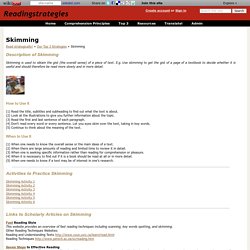
E.g. Use skimming to get the gist of a page of a textbook to decide whether it is useful and should therefore be read more slowly and in more detail. How to Use It (1) Read the title, subtitles and subheading to find out what the text is about. (2) Look at the illustrations to give you further information about the topic. (3) Read the first and last sentence of each paragraph. (4) Don't read every word or every sentence. Reading Stronger, Faster, Better: 5 Activities for Teaching Reading Strategies. How do you teach students to become better readers, especially with academic texts?
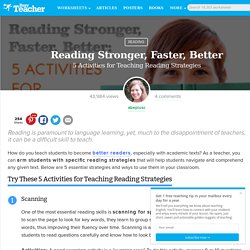
As a teacher, you can arm students with specific reading strategies that will help students navigate and comprehend any given text. Below are 5 essential strategies and ways to use them in your classroom. 1ScanningOne of the most essential reading skills is scanning for specific information. By training students to scan the page to look for key words, they learn to group specific letters together and quickly identify words, thus improving their fluency over time. Scanning is also a critical test-taking skill that allows students to read questions carefully and know how to look back in the text quickly to find the answer.Activities: A good scanning activity is a “running race.” Model and practice these skills with your students regularly and watch over time how they will be reading stronger, better, and faster!
Writing poems with ‘Spark’ Newspaper reading activities. Skimming and Scanning. Skimming and Scanning are two key skills identified in the Programmes of Study for KS2 Reading in the National Curriculum.
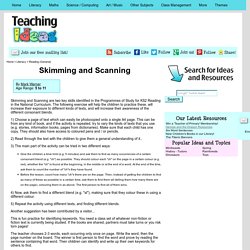
The following exercise will help the children to practice these, will increase their exposure to different kinds of texts, and will increase their awareness of the different consonant blends. 1) Choose a page of text which can easily be photocopied onto a single A4 page. This can be from any kind of book, and if the activity is repeated, try to vary the kinds of texts that you use (e.g. stories, information books, pages from dictionaries).
Make sure that each child has one copy. They should also have access to coloured pens and / or pencils. 2) Read through the text with the children to give them a general understanding of it.. 3) The main part of the activity can be tried in two different ways: Give the children a time limit (e.g. 5 minutes) and ask them to find as many occurrences of a certain consonant blend (e.g.